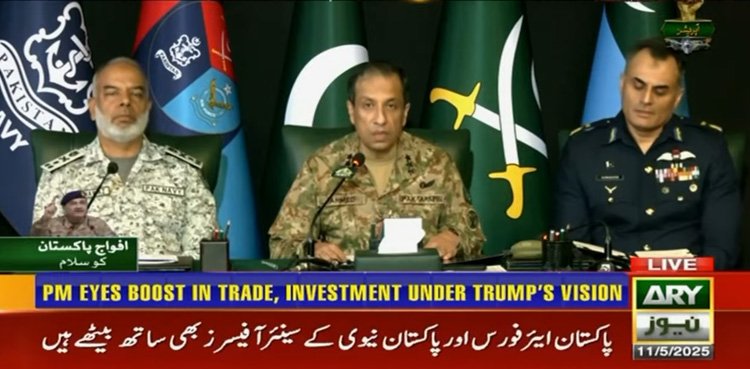
Director General Inter-Services Public Relations (DG ISPR) Lieutenant General Ahmad Sharif Chaudhry, alongside senior officers from the Pakistan Air Force (PAF) and Pakistan Navy (PN) is conducting an important press conference regarding operational details of Operation Bunyan-un-Marsoos.
In a powerful and well-coordinated response to Indian aggression, Pakistan has carried out successful military operations targeting 26 key Indian military sites, said DG ISPR.
The DG ISPR expressed deep gratitude to the youth of Pakistan, calling them “frontline soldiers” in the nation’s defence. He also appreciated the Pakistani media for standing firm like a “ Bunyan-un-Marsoos” against Indian misinformation campaigns.
The spokesperson confirmed that Indian military targets were struck in Suratgarh, Sirsa, Bhuj, Naliya, Adampur, Avantipura, Udhampur, Pathankot, Bathinda, Barnala, Halwara, Srinagar, Jammu, Mamun, and Ambala.
Two S-400 battery systems were specifically targeted and successfully hit in Adampur and Bhuj. BrahMos missile storage facilities in Beas and Nagrota were also destroyed.
The strikes were carried out using Fatah Guided Missile I and II, with extreme precision to avoid civilian casualties.
According to the DG ISPR, Pakistan only targeted locations that were actively used for launching attacks on innocent civilians in Azad Kashmir. Radar systems in Uri and Poonch and military headquarters involved in directing operations against Pakistan were neutralised.
Pakistan’s Armed Forces also carried out significant cyber operations, paralysing key Indian military systems. The DG ISPR said that the military response was “historic and timely,” and that “no one should be in doubt—any attack on our sovereignty will be met with a resolute and effective reply.”
The DG ISPR extended special thanks to the Prime Minister, cabinet members, and political leadership for making bold decisions during a challenging time. He lauded the unity of political parties who stood together for national defence beyond their differences.
He also prayed for the civilians injured in India’s aggression and paid tribute to the martyrs and their families, assuring them that the nation’s thoughts and prayers are with them.
DG ISPR confirmed that the operations destroyed installations used to support terrorist activities within Pakistan. Notably, military intelligence units in Rajouri and Nowshera—identified as key hubs for orchestrating terrorism inside Pakistan—were neutralised. Field operatives of these units were also eliminated.
He stated that the Pakistan Army carried out continuous operations against Indian posts that had been firing on civilians in Azad Jammu and Kashmir. These actions forced several of the Indian posts to raise white flags in surrender.
The ISPR spokesperson also revealed that India violated Pakistan’s airspace using drones to instil fear among the civilian population. In a strategic demonstration of capability, armed Pakistani drones flew over major Indian cities, including the capital, New Delhi, during Operation Bunyan Um Marsoos. The purpose was to highlight the limited utility of drones in modern warfare domains.
Pakistan also launched significant cyberattacks, successfully paralysing Indian military infrastructure. DG ISPR stressed that while Pakistan utilised several of its warfare capabilities during this conflict, others remain reserved for future contingencies.
He clarified that Pakistan’s military response was proportionate and carefully calibrated. Individuals involved in the killing of innocent Pakistani civilians were deliberately chosen as high-value targets. Efforts were made to ensure that no civilians were harmed during the operations.
DG ISPR reiterated the three promises made to the nation: that Pakistan’s response would be strong, that the timing and method would be chosen independently, and that the global media, not just Indian media would take note of the response.
more to follow
